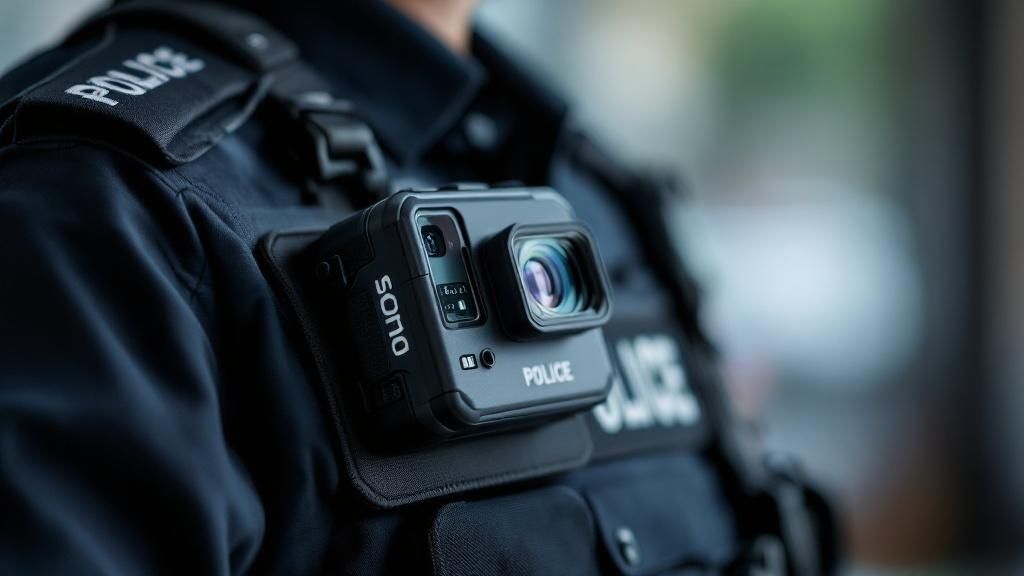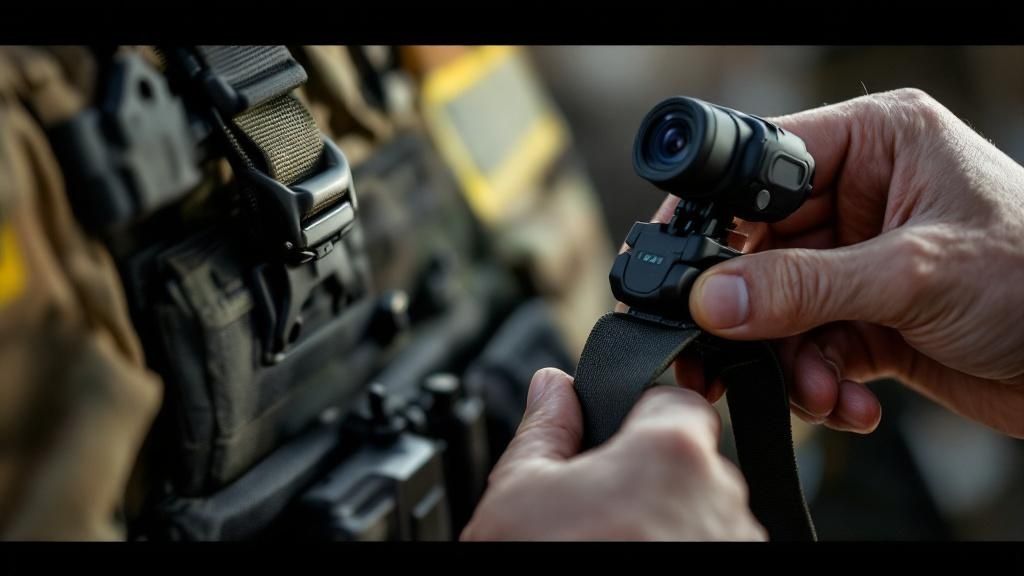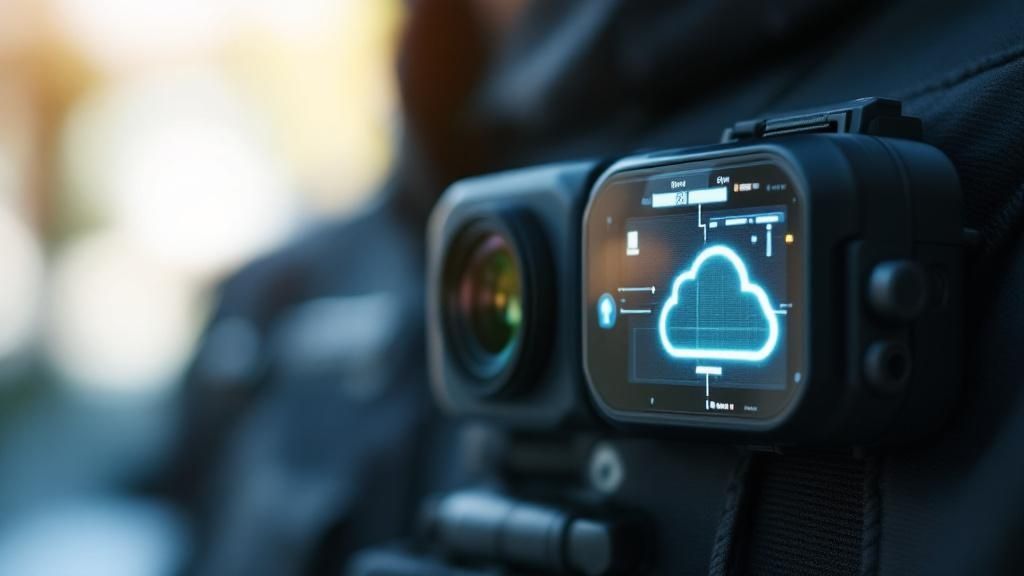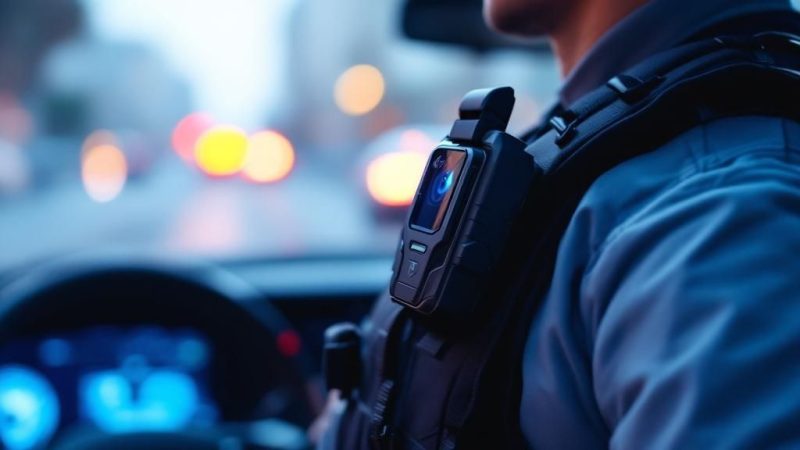Your Guide to the WatchGuard Body Worn Camera
In the world of public safety, things are always changing, but one tool has become absolutely essential: the WatchGuard body worn camera. Think of it as more than just a camera. It’s a core piece of an agency's plan to keep officers safe, build trust with the community, and get a handle on operational risks.
Why Public Safety Agencies Are Turning to WatchGuard Cameras

For today's law enforcement, EMS, and security crews, transparency isn't just a buzzword—it's a necessity. A WatchGuard body camera gives you an unbiased, objective record of what happened. That's a huge deal when it comes to de-escalating tense encounters and protecting your people from baseless complaints.
It all comes down to reliable evidence. When you have clear, indisputable footage, cases get resolved faster. That means less time and money spent on long, drawn-out internal and legal investigations. For example, a clear video of a disputed traffic stop can lead to a quick plea deal, saving dozens of hours in court preparation and litigation costs for a single incident.
A Growing Role in Modern Operations
Adopting this kind of tech isn't just a one-off decision; it's part of a much bigger trend. The market for body-worn cameras is set to jump from USD 2.86 billion in 2025 to USD 4.05 billion by 2030, and law enforcement agencies are the main ones driving that growth.
The environments our public safety pros work in are tough, often as demanding as a military operation. It’s why durability is non-negotiable. You can get a sense of what that looks like by checking out rugged tablet solutions built for the modern battlefield.
Investing in a body camera system is really an investment in risk management. Clear video is one of the best tools out there for shutting down frivolous lawsuits and the legal fees that come with them, saving agencies thousands of dollars every year.
This guide is all about giving you practical insights into WatchGuard’s features and smart ways to deploy them that protect both your officers and your budget.
Understanding Core WatchGuard Camera Features
A WatchGuard body-worn camera is a whole lot more than just a record button on a uniform. It's a purpose-built tool designed from the ground up for the tough realities of public safety work. All its features are built to do one thing: capture undeniable evidence without getting in the way, letting officers keep their focus where it needs to be.
The entire system is built around one non-negotiable principle: high-definition video. When a piece of footage might end up in a report, used for training, or presented in court, "good enough" doesn't cut it. You need crisp, clear video that captures every single detail.
This diagram breaks down the key features that make the WatchGuard camera such a powerful piece of equipment.
These core functions don't work in isolation; they’re designed to work together, providing a complete and trustworthy record of an event as it’s happening.
Capturing What Matters Most
One of the most impressive features is the Record-After-the-Fact technology. It’s like having an instant replay button for real-life events. This lets an officer save video of an incident that already happened, even if they couldn't hit the record button in the heat of the moment.
How does it work? The camera is always in a state of pre-event buffering. This is a game-changer, preventing agencies from losing those critical first few seconds of an encounter before the camera was officially activated. A practical example is a sudden physical altercation during a routine conversation; an officer can secure the scene first and then press the button to save the entire event, including the moments leading up to it. It's an absolute lifesaver for documenting sudden, unpredictable incidents.
A huge side benefit of having this clear, buffered video is how it cuts down on frivolous complaints. When an entire encounter is captured from start to finish, agencies often see a 90% drop in unsubstantiated claims against officers. That translates into major savings on legal and admin costs.
To bring it all together, let’s take a look at the most impactful features and what they mean for officers in the field.
WatchGuard Body Worn Camera Key Feature Breakdown
| Feature | What It Does | Practical Benefit for Officers |
|---|---|---|
| HD Video Resolution | Captures footage in high definition (1080p or higher) for maximum clarity. | Ensures every detail is visible for accurate reporting, evidence, and training review. |
| Record-After-the-Fact | Continuously buffers video, allowing officers to save recordings of events that just occurred. | Prevents loss of crucial evidence from sudden incidents before the record button is pressed. |
| Rugged, Durable Design | Built to military-grade standards (MIL-STD-810G) to withstand drops, water, and extreme temperatures. | The camera keeps working through physical altercations, bad weather, and daily wear and tear. |
| Automatic Activation | Can be configured to start recording automatically when a vehicle's light bar is activated or a firearm is drawn. | Removes the need for manual activation during high-stress situations, ensuring events are captured. |
Ultimately, a truly effective body camera has to be built like a tank. A rugged, durable design means the device can handle the physical demands of the job, from pouring rain to a physical struggle. That kind of reliability means a lower total cost of ownership over the camera's lifespan, with fewer devices needing to be repaired or replaced.
Pairing these powerful cameras with a central platform is where their value really multiplies. You can explore the comprehensive features of Resgrid to see just how seamlessly dispatch, evidence management, and on-the-ground recording can all connect.
How Synchronized In-Car and Body Cameras Work

A standalone body camera is a decent start, but its true power gets unlocked when it’s part of a team. One of the biggest wins with the WatchGuard body worn camera is how it talks to the 4RE in-car video system. They don’t just coexist; they create a single, unified recording ecosystem that captures an incident from every critical angle.
This synchronized approach is a serious force multiplier. Picture a high-risk traffic stop at night. The second an officer hits the vehicle’s light bar, the in-car system and every nearby WatchGuard body camera can fire up and start recording. Automatically. Nobody has to think about fumbling for a button.
Creating a Complete Picture
That automatic activation is a game-changer for officer safety. When things get tense, an officer’s focus needs to be on the threat, not on their gear. By automating the recording, agencies guarantee the entire event is captured from multiple viewpoints, creating a comprehensive and undeniable record.
The real money-saving aspect of a synchronized system is its ability to provide irrefutable context. A single camera angle can be misleading, but multiple, synchronized feeds make it nearly impossible to dispute the facts. This dramatically reduces the time and cost associated with investigating complaints and fighting frivolous lawsuits.
This is something isolated, standalone cameras just can't do. They often miss those crucial first moments before an officer can manually hit record, leaving big gaps in the evidence.
From Individual Devices to a Unified System
This synchronized network gives you a much fuller picture for every stage that follows an incident:
- Investigations: Detectives get a 360-degree view of the scene. It helps them piece together what really happened with far greater accuracy.
- Training: You can use footage from multiple angles to review tactics and split-second decisions, creating invaluable learning opportunities.
- Court Proceedings: A synchronized, multi-camera recording presents a clear, compelling narrative that’s incredibly difficult for anyone to challenge.
Ultimately, this approach transforms a box of individual cameras into a single, intelligent evidence-capturing network. It’s peace of mind that when an incident kicks off, the full story is always recorded.
Deploying Your Cameras and Managing Evidence Costs
So you’ve got the cameras. Now what? Getting from a box of new tech to a fully implemented system that works in the field takes a solid playbook. A successful rollout of your WatchGuard body-worn camera system really comes down to three things: clear usage policies, training that actually sticks, and a simple workflow for managing evidence.
Getting this foundation right from the start is what separates a long-term asset from a short-term headache. The goal is to make using the camera second nature for your team. Policies need to be crystal clear about when to hit record, how to tag footage, and how long to keep it. And training? It has to be more than just a "here's the on-button" session. It should cover how these cameras can be a tool for de-escalation and a game-changer for preserving evidence.
Choosing the Right Storage to Save Money
One of the biggest line items you'll face over time is data storage. You've really got two paths to go down, each with its own price tag and set of headaches.
- On-Premise Storage: This is the old-school way. You buy the servers, you set up the IT infrastructure, and you own it all. It’s a big check to write upfront, and while the monthly costs might seem lower, you're on the hook for all the maintenance, security, and inevitable upgrades down the road.
- Cloud Storage: This approach turns a massive capital expense into a predictable operational one. You don't need a huge upfront investment, and you're not managing servers in a closet somewhere. It’s built to scale, and it takes a huge burden off your internal IT crew.
For most agencies, a cloud solution just makes more sense financially. You can scale your storage up or down as your needs change, and things like software updates and security are usually baked into the subscription. It’s a lot like exploring the straightforward pricing for Resgrid's platform; you can see how a service model compares to the cost of buying and maintaining hardware yourself.
Automated Redaction: A Practical Cost-Saving Tool
One of the biggest hidden costs that sneaks up on agencies is fulfilling public records requests. Manually blurring out faces, license plates, and other private info from hours and hours of video is a soul-crushing, time-consuming task. This is where automated redaction tools pay for themselves almost immediately.
By using software to automatically find and blur sensitive information, agencies can slash their redaction time by up to 90%. A task that once took hundreds of man-hours becomes a manageable part of the job, saving thousands in personnel costs every single year.
This kind of efficiency is becoming non-negotiable. The global body-worn camera market is projected to hit USD 2.66 billion by 2032, and that growth is being fueled by the demand for accountability and smart features just like this. The numbers don't lie—investing in tools that save time is just good financial sense.
Real-World Scenarios and Tangible Benefits

It’s one thing to talk about features, but the real worth of a WatchGuard body worn camera hits home when you see it on the streets. These aren't just gadgets; they provide clear, undeniable proof that shields agencies from liability and genuinely improves how things get done in public safety.
For law enforcement, the most immediate payback comes from a nosedive in frivolous complaints. When an entire interaction is captured in high-definition, those baseless claims tend to evaporate before they ever become a costly internal investigation or, worse, a lawsuit. This isn't just a concept—it's thousands of dollars in legal fees and administrative time saved, right there.
A single piece of clear video evidence can be the deciding factor in a legal dispute. It can lead to faster case resolutions, reduced court time, and fewer payouts for unsubstantiated allegations, proving the camera's value as a powerful risk management tool.
Beyond just defending against lawsuits, this footage helps clear cases faster. Detectives and prosecutors can use solid video evidence to secure quicker plea bargains, which takes a huge strain off the entire judicial system. The camera isn't just playing defense; it’s an active player in delivering efficient justice.
Applications Beyond Law Enforcement
The game-changing impact of a WatchGuard body camera doesn’t stop at traffic stops and arrests. We're seeing other public safety branches realize just how valuable this tech can be for them, too.
- Fire Departments: The moment a fire is out, the investigation starts. Firefighters with body cams can document the scene as they find it, capturing critical evidence for arson investigations before anything gets moved or disturbed. That footage is a time-stamped, unshakeable record of the environment. For example, capturing the initial pattern of smoke and flame from a window can be crucial evidence that is otherwise lost moments later.
- EMS Teams: Paramedics are using body camera footage for some of the best training and quality assurance they've ever had. Being able to review real-world patient interactions helps teams fine-tune their medical protocols, sharpen communication, and make sure they’re consistently delivering the highest standard of care.
Enhancing Training and Officer Safety
When it comes down to it, the single most important benefit is safety. Every piece of footage from a real incident becomes a powerful addition to your training library. Agencies can break down tactical decisions and de-escalation techniques from actual events, offering lessons that are miles ahead of any simulated scenario.
This constant loop of recording, reviewing, and refining tactics creates better, more prepared first responders. By learning from tangible, real-world examples, teams improve their decision-making under incredible stress. That leads to safer outcomes for everyone—the public and the responders themselves. Every call becomes a chance to learn.
Maximizing Safety and Accountability with WatchGuard
Let's be clear: a WatchGuard body-worn camera is a lot more than just a camera. Think of it as a key piece of a much larger evidence ecosystem, one that shores up officer safety, builds trust with the community, and frankly, just makes agency workflows smoother. It provides that objective record that can protect an officer from a false complaint just as easily as it can provide the crystal-clear evidence needed to close a case.
But the real power isn't in the hardware itself—it's in how you roll it out. The difference between a camera that just sits on a uniform and a powerful accountability tool comes down to smart deployment, clear-as-day usage policies, and an evidence management plan that doesn't create more headaches. Get that right, and every piece of footage serves its purpose, whether it's in the courtroom or a training debrief.
At the end of the day, the biggest return on your investment is a safer environment for everyone. This technology is foundational for modern public safety—it's a tool that protects your officers, your citizens, and your agency's budget.
For agencies looking to the future, it’s best to stop thinking of this technology as an expense and start seeing it as an essential investment. When you integrate it properly, you're not just protecting your people; you're actively strengthening the bond between your professionals and the communities they serve. If you want to dive deeper into building out a solid operational framework, take a look at our guide on improving your security and dispatch management systems.
Got Questions? We've Got Answers.
Jumping into any new technology brings up a lot of practical questions. It’s a big investment, and you need to get it right. Let's break down some of the most common things agencies ask about the WatchGuard body camera system so you can make a decision you're confident in.
How Much Does a WatchGuard Body Camera System Cost?
The final price tag really depends on a few key things: how many cameras you need, the software licenses, and where you plan to store all that video data. The cameras themselves are a one-time purchase, but don't forget about the data. The ongoing cost of video storage is usually the biggest expense over the long haul.
Here's a tip to keep your budget in check: look for a bundled package. Instead of buying 50 cameras and then scrambling to figure out storage separately, ask your vendor for a multi-year deal. This should lock in a predictable price for the cameras, the evidence management software, and a set amount of cloud storage, protecting you from surprise cost hikes down the road.
One of the most common and costly mistakes we see is overestimating data storage needs. Before you sign anything, do a real needs analysis. Start with a conservative estimate and pick a plan that lets you scale up without breaking the bank.
What Is the Battery Life of the WatchGuard V300?
The WatchGuard V300 is built to go the distance, easily lasting a full shift with over 12 hours of continuous recording on a single charge. But honestly, its best feature is the swappable battery.
Think about it. An officer is working an extended detail at a protest that runs late into the night. Instead of having to pull a camera out of service to find a charger, they can just pop in a fresh battery in a few seconds and keep rolling. This completely eliminates camera downtime during critical events, which is a massive advantage over cameras with built-in batteries.
Can WatchGuard Footage Be Redacted for Public Release?
Absolutely, and this is where you can see some serious time and money savings. The WatchGuard Evidence Library software includes some powerful, AI-assisted redaction tools that can automatically find and blur faces, license plates, and other sensitive info.
This automated feature is a total game-changer. Imagine you get a public records request for an incident involving multiple officers and hours of video. Manually redacting that footage could tie up a staff member for days. With this software, you can knock that task down to just a few hours of final review. That's a direct and immediate savings in personnel costs, just for a single request.
Here at Resgrid, our focus is on giving you tools that make your operations safer and more efficient. Find out how our dispatch and management platform can work with your existing tech to build a complete solution. Discover what Resgrid can do for you today.

